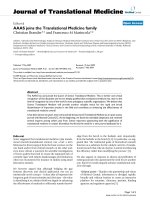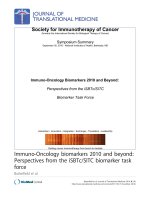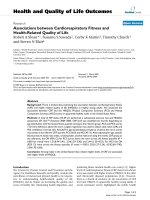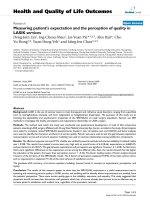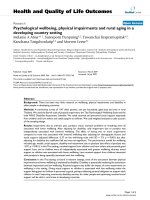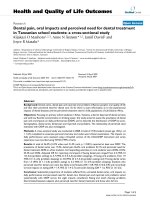báo cáo hóa học: " Neuro-Inflammation, Blood-Brain Barrier, Seizures and Autism" pot
Bạn đang xem bản rút gọn của tài liệu. Xem và tải ngay bản đầy đủ của tài liệu tại đây (332.23 KB, 16 trang )
This Provisional PDF corresponds to the article as it appeared upon acceptance. Fully formatted
PDF and full text (HTML) versions will be made available soon.
Neuro-Inflammation, Blood-Brain Barrier, Seizures and Autism
Journal of Neuroinflammation 2011, 8:168 doi:10.1186/1742-2094-8-168
Theoharis C Theoharides ()
Bodi Zhang ()
ISSN 1742-2094
Article type Hypothesis
Submission date 19 September 2011
Acceptance date 30 November 2011
Publication date 30 November 2011
Article URL />This peer-reviewed article was published immediately upon acceptance. It can be downloaded,
printed and distributed freely for any purposes (see copyright notice below).
Articles in JNI are listed in PubMed and archived at PubMed Central.
For information about publishing your research in JNI or any BioMed Central journal, go to
/>For information about other BioMed Central publications go to
/>Journal of Neuroinflammation
© 2011 Theoharides and Zhang ; licensee BioMed Central Ltd.
This is an open access article distributed under the terms of the Creative Commons Attribution License ( />which permits unrestricted use, distribution, and reproduction in any medium, provided the original work is properly cited.
1
Neuro-Inflammation, Blood-Brain Barrier, Seizures and Autism
Theoharis C. Theoharides
1,2,3,4,*
, Bodi Zhang
1,2
Affiliations:
1
Molecular Immunopharmacology and Drug Discovery Laboratory, Department of Molecular
Physiology and Pharmacology, Tufts University School of Medicine, 136 Harrison Avenue, Boston, MA,
USA
2
Departments of Biochemistry, Tufts University School of Medicine, 136 Harrison Avenue, Boston, MA,
USA
3
Departments of Internal Medicine, Tufts University School of Medicine and Tufts Medical Center, 136
Harrison Avenue, Boston, MA, USA
4
Departments of Psychiatry, Tufts University School of Medicine and Tufts Medical Center, 136
Harrison Avenue, Boston, MA, USA
* Corresponding Author: Theoharis C. Theoharides .
2
Abstract
Many children with Autism Spectrum Diseases (ASD) present with seizure activity, but the
pathogenesis is not understood. Recent evidence indicates that neuro-inflammation could contribute to
seizures. We hypothesize that brain mast cell activation due to allergic, environmental and/or stress
triggers could lead to focal disruption of the blood-brain barrier and neuro-inflammation, thus
contributing to the development of seizures. Treating neuro-inflammation may be useful when anti-
seizure medications are ineffective.
Key words: Autism, Blood-Brain Barrier, Mast cells, Neuroinflammation, Flavonoids
3
Background:
Autism Spectrum Disorders (ASD) are pervasive neurodevelopmental disorders affecting almost
1/100 children and are characterized by difficulties in social skills, concentration, language, learning and
stereotypic behaviors
[1,2,3]. About 22-30% of children with ASD also develop seizures with no
specific underlying pathology, and no obvious or classic EEG changes [1,4,5,6,7]. These rates of
seizures in ASD are about ten times higher than that in the general population [8]. This high rate is not
found in other neurologic diseases such as schizophrenia [9]. Alterations in architecture of cortical
neurons were recently reported in autism [10] and may contribute to seizures.
Epileptic symptoms in children with ASD were recently considered to be related to immune-
mediated pathogenesis
[11]. In fact, ASD are associated with some immune dysfunction, such as
elevated antibody levels directed against the fetal brain [12,13,14,15] suggesting BBB disruption. A
recent paper from the Autism Phenome Project reported that 42% of 3 year old children with ASD and
controls had plasma antibodies against GABAergic cerebellar neuron proteins, but those control children
had high scores on the Child Behavior Check list, suggesting that they may constitute a susceptible
subtype for ASD [16]. Moreover, IL-6 expression was elevated in the brains of ASD patients [17], while
increased serum IL-6 was linked to the expression of an autistic phenotype in mice [18,19].
There is new evidence that the environment contributes significant to ASD pathogenesis [20].
Many ASD patients suffer from food allergies [21]. Moreover, 25% of ASD children have “allergic-
like” symptomatology
[22], but often without positive skin or RAST tests, suggesting mast cell
activation by non-allergic triggers [23], including mercury
[24]. Many studies delineate the importance
of mast cells in both innate and acquired immunity [25], as well as in inflammation
[26]. Substances
originating in the gut or the brain can trigger mast cells to release mediators that could disrupt the gut-
blood barrier and blood-brain barrier (BBB), thus contributing to the pathogenesis of autism
[27]. Many
4
mediators, such as IL-6
[28], can be released from mast cells “selectively”
[29], making histological
evaluation impossible. More importantly, mast cells have been implicated in the pathogenesis of
seizures. One study using a mouse model showed that the non-allergic mast cell trigger compound 48/80
significantly increased the rate of seizures in mice induced by electric shock, and this effect was
eliminated in mast cell-depleted mice [30]. Moreover, the mast cell trigger neurotensin (NT) [31] can
facilitate N-Methyl-D-aspartate (NMDA)-induced excitation of cortical neurons [32] and seizure activity
in rodents [33]. NT was increased in young children with autism [34], and was proposed as a possible
therapeutic target for autism also due to its ability to induce neurotoxicity [35].
Children with mastocytosis, a spectrum of diseases that present with skin allergies and diarrhea,
also complain of learning disabilities, hyperactivity and difficulty focusing (“brain fog”), reminiscent of
ASD [36,37]. In fact, children with mastocytosis have a 10-fold higher prevalence of ASD (1/10
children) than that reported for the general population (1/100 children) [38]. Interestingly, mastocytosis
patients also have high serum IL-6 levels [39,40] and develop seizures [41]. Also, a solitary
mastocytoma produced symptoms mimicing seizures [42].
Hypothesis:
Immune dysfunction and inflammation appear to alter BBB integrity
[43,44]. Recent evidence
indicates that the integrity of the BBB, especially leukocyte endothelial adhesion may also be involved
in the pathogenesis of epilepsy [45], a phenomenon described as “immunology: barrier to electrical
storms”
[46].
Mast cells were considered as the “immune gate to the brain” [47]. ASD patients are prone
to stress
[48], and prenatal stress has been linked to risk of autism. [49] The brain, especially the
hypothalamus, contains many mast cells critically located around the BBB
, and that stress activates
5
brain mast cells leading to BBB disruption
[50]. Moreover, corticotropin-releasing hormone (CRH),
secreted under stress, can activate mast cells
[51] and is responsible for mast cell-dependent BBB
disruption [50,51]. The possible involvement of mast cells is further supported by the ability of
histamine-1 receptors to augment seizures
[52]. Brain mast cells also contribute to the pathogenesis of
migraine headaches [53] that increase the likelihood of seizures [54]. Local activation of brain mast
cells could lead to focal disruption of the BBB, permitting focal neuro-inflammation that could become
an epileptogenic site (Fig. 1). This process could worsen by activation of Fcgamma receptors (FcγRI)
on neurons that could contribute to brain cell death after injection of the epileptogenic kainic acid
[55].
Moreover, Fcepsilon receptors (FcεRI), typically thought to be expressed only by mast cells and
basophils, were recently identified on neurons [56] implying that allergic triggers may even affect the
neurons directly, once the BBB has been disrupted to permit entry of immunoglobulins. A recent
publication reported that increased serum level of “high mobility group box 1 protein (HMGB1) in
young autistic patients [57]. HMGB1 is released from neurons following neurotoxicity [58] and it was
recently shown to constitute a pro-seizure pathway through activation of toll-like receptors (TLR-4) in
mice [59]. We recently showed that mast cell activation leads to mitochondrial translocation to the cell
surface [60], and secretion of extracellular mtDNA [34]. We also showed that serum of children with
autism had increased levels of extracellular mitochondrial DNA [61]. Damaged Associated Molecular
Patterns (DAMPs), which include mitochondrial DNA, were reported to be released from damaged cells
in trauma patients and activate TLR leading to auto-inflammation [62]. Mitochondrial DNA was also
reported to be directly neurotoxic and alter behavior in mice [63].
Anticonvulsant medications often are ineffective in both ASD and mastocytosis patients with
seizures [64]. It would, therefore, be important to use treatment approaches directed to the core
6
symptoms of ASD and/or brain mast cell activation and inflammation [23]. Use of select, natural,
flavonoids, may be useful because of their anti-oxidant and anti-inflammatory ability [65]. Luteolin is a
flavone contained in chamomile and chrysanthemum.
Increasing evidence indicates that luteolin has
potent antioxidant, free radical scavenger, anti-inflammatory and mast cell inhibitory activity [66]. In
addition, luteolin inhibits microglia IL-6 release [67,68], as well as mimics the activity of brain-derived
neurotrophic factor (BDNF) [69]. Luteolin also inhibits autistic-like behavior in mice [70]. Luteolin also
inhibits mast cell-dependent stimulation of activated T cells [71], as well as activated peripheral blood
mononuclear cells from patients with the brain inflammatory disease multiple sclerosis [72]. Moreover,
the structural flavone analogue, quercetin, found in citrus pulp and peels, is also a potent mast cell
inhibitor [73] and has anti-seizure activity [74], as does its natural glycoside rutin [75]. Luteolin may,
therefore, be useful for the treatment of neuroinflammation, including seizures in ASD children,
especially if administered in formulations
that permit sufficient oral absorption.
Implications
In conclusion, evidence reviewed above indicates a possible association between
neuroinflammation, mast cell activation and seizures, through secretion of pro-inflammatory mediators
and regulation of the BBB permeability. Mast cell function inhibitors, especially those blocking the
effect of NT, such as luteolin, may serve as novel therapeutic agents for the treatment of autism and
related seizures.
7
Competing Interests
TCT is the inventor of US patents No. 6,624,148; 6,689,748; 6,984,667, and EPO 1365777, which cover
methods and compositions of mast cell blockers, including flavonoids, , US patents 7,906,153 and
12/861,152 (allowed on September, 22, 2011) for treatment of neuroinflammatory conditions, as well
as US patent applications No.12/534,571 and No.13/009,282 for the diagnosis and treatment of ASD.
TCT is also the inventor of the dietary supplement, NeuroProtek®, which has the US trademark No
3,225,924.
Authors' contributions
TCT and BZ prepared, read, and approved this manuscript.
Acknowledgments
Aspects of our work described above were funded by NIH grants NS38326 and AR47652, as well as the
Autism Collaborative, the Autism Research Institute, National Autism Association, Safe Minds and
Theta Biomedical Consulting and Development Co., Inc. (Brookline, MA, USA).
This paper is dedicated to the memory of Elia Tembenis, a young boy with autism and seizures.
8
References
1. Kogan, M. D., Blumberg, S. J., Schieve, L. A., Boyle, C. A., Perrin, J. M., Ghandour, R. M.,
Singh, G. K., Strickland, B. B., Trevathan, E., and van Dyck, P. C.: Prevalence of parent-
reported diagnosis of autism spectrum disorder among children in the US, 2007. Pediatrics
2009, 5:1395-1403.
2. Fombonne, E.: Epidemiology of pervasive developmental disorders. Pediatric Research 2009,
65:591-598.
3. Volkmar, F. R., State, M., and Klin, A.: Autism and autism spectrum disorders: diagnostic
issues for the coming decade. J Child Psychol.Psychiatry 2009, 50:108-115.
4. Tuchman, R. and Rapin, I.: Epilepsy in autism. Lancet Neurol. 2002, 1:352-358.
5. Trevathan, E.: Seizures and epilepsy among children with language regression and autistic
spectrum disorders. J Child Neurol. 2004, 19 Suppl 1:S49-S57.
6. Fombonne, E. and du, Mazaubrun C.: Prevalence of infantile autism in four French regions.
Soc.Psychiatry Psychiatr.Epidemiol. 1992, 27:203-210.
7. Volkmar, F. R. and Nelson, D. S.: Seizure disorders in autism. J Am Acad.Child
Adolesc.Psychiatry 1990, 29:127-129.
8. Clarke, D. F., Roberts, W., Daraksan, M., Dupuis, A., McCabe, J., Wood, H., Snead, O. C., III, and
Weiss, S. K.: The prevalence of autistic spectrum disorder in children surveyed in a tertiary
care epilepsy clinic. Epilepsia 2005, 46:1970-1977.
9. Hyde, T. M. and Weinberger, D. R.: Seizures and schizophrenia. Schizophr.Bull. 1997, 23:611-
622.
10. Oblak, A. L., Rosene, D. L., Kemper, T. L., Bauman, M. L., and Blatt, G. J.: Altered posterior
cingulate cortical cyctoarchitecture, but normal density of neurons and interneurons in the
posterior cingulate cortex and fusiform gyrus in autism. Autism Res 2011, 4:200-211.
11. Specchio, N., Fusco, L., Claps, D., and Vigevano, F.: Epileptic encephalopathy in children
possibly related to immune-mediated pathogenesis. Brain Dev. 2010, 32:51-56.
12. Enstrom, A. M., Van de Water, J. A., and Ashwood, P.: Autoimmunity in autism.
Curr.Opin.Investig.Drugs 2009, 10:463-473.
13. Theoharides, T. C., Kempuraj, D., and Redwood, L.: Autism: an emerging 'neuroimmune
disorder' in search of therapy. Exp Opinion on Pharmacotherapy 2009, 10:2127-2143.
14. Goines, P. and Van de, Water J.: The immune system's role in the biology of autism.
Curr.Opin.Neurol 2010, 23:111-117.
9
15. Wills, S., Cabanlit, M., Bennett, J., Ashwood, P., Amaral, D. G., and Van de, Water J.: Detection
of autoantibodies to neural cells of the cerebellum in the plasma of subjects with autism
spectrum disorders. Brain Behav.Immun. 2009, 23:64-74.
16. Rossi, C. C., Van de, Water J., Rogers, S. J., and Amaral, D. G.: Detection of plasma
autoantibodies to brain tissue in young children with and without autism spectrum
disorders. Brain Behav.Immun. 2011, 25:1123-1135.
17. Li, X., Chauhan, A., Sheikh, A. M., Patil, S., Chauhan, V., Li, X. M., Ji, L., Brown, T., and Malik,
M.: Elevated immune response in the brain of autistic patients. J.Neuroimmunol. 2009,
207:111-116.
18. Dahlgren, J., Samuelsson, A. M., Jansson, T., and Holmang, A.: Interleukin-6 in the maternal
circulation reaches the rat fetus in mid-gestation. Pediatr.Res 2006, 60:147-151.
19. Smith, S. E., Li, J., Garbett, K., Mirnics, K., and Patterson, P. H.: Maternal immune activation
alters fetal brain development through interleukin-6. Journal of Neuroscience 2007, 27:10695-
10702.
20. Hallmayer, J., Cleveland, S., Torres, A., Phillips, J., Cohen, B., Torigoe, T., Miller, J., Fedele, A.,
Collins, J., Smith, K., Lotspeich, L., Croen, L. A., Ozonoff, S., Lajonchere, C., Grether, J. K., and
Risch, N.: Genetic Heritability and Shared Environmental Factors Among Twin Pairs With
Autism. Arch.Gen.Psychiatry 2011,
21. Jyonouchi, H.: Autism spectrum disorders and allergy: observation from a pediatric
allergy/immunology clinic. Expert.Rev.Clin Immunol 2010, 6:397-411.
22. Angelidou, A., Alysandratos, K. D., Asadi, S., Zhang, B., Francis, K., Vasiadi, M.,
Kalogeromitros, D., and Theoharides, T. C.: Brief Report: "Allergic Symptoms" in Children
with Autism Spectrum Disorders. More than Meets the Eye? J Autism Dev.Disord. 2011,
41:1579-1585.
23. Theoharides, T. C., Angelidou, A., Alysandratos, K. D., Zhang, B., Asadi, S., Francis, K., Toniato,
E., and Kalogeromitros, D.: Mast cell activation and autism. Biochim.Biophys.Acta 2011,
24. Kempuraj, D., Asadi, S., Zhang, B., Manola, A., Hogan, J., Peterson, E., and Theoharides, T. C.:
Mercury induces inflammatory mediator release from human mast cells. J Neuroinflammation
2010, 7:20.
25. Galli, S. J., Nakae, S., and Tsai, M.: Mast cells in the development of adaptive immune
responses. Nat Immunol 2005, 6:135-142.
26. Theoharides, T. C., Alysandratos, K. D., Angelidou, A., Delivanis, D. A., Sismanopoulos, N.,
Zhang, B., Asadi, S., Vasiadi, M., Weng, Z., Miniati, A., and Kalogeromitros, D.: Mast cells and
inflammation. Biochim.Biophys.Acta 2010,
27. Theoharides, T. C., Doyle, R., Francis, K., Conti, P., and Kalogeromitros, D.: Novel therapeutic
targets for autism. Trends Pharmacol Sci. 2008, 29:375-382.
10
28. Kandere-Grzybowska, K, Letourneau, R., Kempuraj, D., Donelan, J., Poplawski, S., Boucher, W.,
Athanassiou, A., and Theoharides, T. C.: IL-1 induces vesicular secretion of IL-6 without
degranulation from human mast cells. J Immunol 2003, 171:4830-4836.
29. Theoharides, T. C., Kempuraj, D., Tagen, M., Conti, P., and Kalogeromitros, D.: Differential
release of mast cell mediators and the pathogenesis of inflammation. Immunol Rev 2007,
217:65-78.
30. Yillar, D. O. and Kucukhuseyin, C.: The effects of compound 48/80, morphine, and mast cell
depletion on electroshock seizure in mice. J Basic Clin Physiol Pharmacol. 2008, 19:1-14.
31. Singh, L. K., Pang, X., Alexacos, N., Letourneau, R., and Theoharides, T. C.: Acute
immobilization stress triggers skin mast cell degranulation via corticotropin-releasing
hormone, neurotensin and substance P: A link to neurogenic skin disorders. Brain Behav
Immunity 1999, 13:225-239.
32. Antonelli, T., Ferraro, L., Fuxe, K., Finetti, S., Fournier, J., Tanganelli, S., De, Mattei M., and
Tomasini, M. C.: Neurotensin enhances endogenous extracellular glutamate levels in primary
cultures of rat cortical neurons: involvement of neurotensin receptor in NMDA induced
excitotoxicity. Cereb.Cortex 2004, 14:466-473.
33. Shulkes, A., Harris, Q. L., Lewis, S. J., Vajda, J. E., and Jarrott, B.: Regional brain
concentrations of neurotensin following amygdaloid kindled and cortical suprathreshold
stimulation-induced seizures in the rat. Neuropeptides 1988, 11:77-81.
34. Angelidou, A, Francis, K, Vasiadi, M, Alysandratos, K-D, Zhang, B, Theoharides, A., Lykouras,
L, Kalogeromitros, D, and Theoharides, TC: Neurotensin is increased in serum of young
children with autistic disorder. J Neuroinflammation 2010, 7:48.
35. Ghanizadeh, A.: Targeting neurotensin as a potential novel approach for the treatment of
autism. J Neuroinflammation 2010, 7:58.
36. Valent, P., Akin, C., Escribano, L., Fodinger, M., Hartmann, K., Brockow, K., Castells, M., Sperr,
W. R., Kluin-Nelemans, H. C., Hamdy, N. A., Lortholary, O., Robyn, J., van, Doormaal J., Sotlar,
K., Hauswirth, A. W., Arock, M., Hermine, O., Hellmann, A., Triggiani, M., Niedoszytko, M.,
Schwartz, L. B., Orfao, A., Horny, H. P., and Metcalfe, D. D.: Standards and standardization in
mastocytosis: consensus statements on diagnostics, treatment recommendations and response
criteria. Eur.J Clin Invest 2007, 37:435-453.
37. Metcalfe, D. D.: Mast cells and mastocytosis. Blood 2008, 112:946-956.
38. Theoharides, T. C.: Autism spectrum disorders and mastocytosis. Int J Immunopathol
Pharmacol 2009, 22:859-865.
39. Brockow, K., Akin, C., Huber, M., and Metcalfe, D. D.: IL-6 levels predict disease variant and
extent of organ involvement in patients with mastocytosis. Clin Immunol 2005, 115:216-223.
11
40. Theoharides, T. C., Boucher, W., and Spear, K.: Serum interleukin-6 reflects disease severity
and osteoporosis in mastocytosis patients. Int Arch Allergy Immunol 2002, 128:344-350.
41. Sarrot-Reynauld, F., Massot, C., Amblard, P., Rousset, H., Da, Costa A., Vital-Durand, D., Ninet,
J., and Decousus, H.: [Systemic mastocytosis: incidence and risks of vasomotor seizures].
Rev.Med Interne 1993, 14:1034.
42. Krowchuk, D. P., Williford, P. M., Jorizzo, J. L., and Kandt, R. S.: Solitary mastocytoma
producing symptoms mimicking those of a seizure disorder. J Child Neurol 1994, 9:451-453.
43. Banks, W. A. and Erickson, M. A.: The blood-brain barrier and immune function and
dysfunction. Neurobiol.Dis. 2010, 37:26-32.
44. Quan, N.: Immune-to-brain signaling: how important are the blood-brain barrier-
independent pathways? Mol.Neurobiol. 2008, 37:142-152.
45. Fabene, P. F., Navarro, Mora G., Martinello, M., Rossi, B., Merigo, F., Ottoboni, L., Bach, S.,
Angiari, S., Benati, D., Chakir, A., Zanetti, L., Schio, F., Osculati, A., Marzola, P., Nicolato, E.,
Homeister, J. W., Xia, L., Lowe, J. B., McEver, R. P., Osculati, F., Sbarbati, A., Butcher, E. C.,
and Constantin, G.: A role for leukocyte-endothelial adhesion mechanisms in epilepsy.
Nat.Med. 2008, 14:1377-1383.
46. Ransohoff, R. M.: Immunology: Barrier to electrical storms. Nature 2009, 457:155-156.
47. Theoharides, T. C.: Mast cells: the immune gate to the brain. Life Sci 1990, 46:607-617.
48. Gillott, A. and Standen, P. J.: Levels of anxiety and sources of stress in adults with autism. J
Intellect.Disabil. 2007, 11:359-370.
49. Kinney, D. K., Munir, K. M., Crowley, D. J., and Miller, A. M.: Prenatal stress and risk for
autism. Neurosci.Biobehav.Rev. 2008, 32:1519-1532.
50. Esposito, P., Chandler, N., Kandere-Grzybowska, K, Basu, S., Jacobson, S., Connolly, R., Tutor,
D., and Theoharides, T. C.: Corticotropin-releasing hormone (CRH) and brain mast cells
regulate blood-brain-barrier permeability induced by acute stress. J Pharmacol Exp Ther
2002, 303:1061-1066.
51. Theoharides, T. C. and Konstantinidou, A.: Corticotropin-releasing hormone and the blood-
brain-barrier. Front Biosci 2007, 12:1615-1628.
52. Rehni, A. K., Singh, T. G., Singh, N., and Arora, S.: Tramadol-induced seizurogenic effect: a
possible role of opioid-dependent histamine H1 receptor activation-linked mechanism.
Naunyn Schmiedebergs Arch.Pharmacol 2010, 381:11-19.
53. Theoharides, T. C., Donelan, J., Kandere-Grzybowska, K., and Konstantinidou, A.: The role of
mast cells in migraine pathophysiology. Brain Res Rev 2005, 49:65-76.
12
54. Ottman, R. and Lipton, R. B.: Comorbidity of migraine and epilepsy. Neurology 1994, 44:2105-
2110.
55. Suemitsu, S., Watanabe, M., Yokobayashi, E., Usui, S., Ishikawa, T., Matsumoto, Y., Yamada, N.,
Okamoto, M., and Kuroda, S.: Fcgamma receptors contribute to pyramidal cell death in the
mouse hippocampus following local kainic acid injection. Neuroscience 2010, 166:819-831.
56. van der, Kleij H., Charles, N., Karimi, K., Mao, Y. K., Foster, J., Janssen, L., Chang, Yang P.,
Kunze, W., Rivera, J., and Bienenstock, J.: Evidence for neuronal expression of functional Fc
(epsilon and gamma) receptors. The Journal of Allergy and Clinical Immunology 2010, 125:757-
760.
57. Emanuele, E., Boso, M., Brondino, N., Pietra, S., Barale, F., Ucelli di, Nemi S., and Politi, P.:
Increased serum levels of high mobility group box 1 protein in patients with autistic
disorder. Prog.Neuropsychopharmacol.Biol.Psychiatry 2010, 34:681-683.
58. Faraco, G., Fossati, S., Bianchi, M. E., Patrone, M., Pedrazzi, M., Sparatore, B., Moroni, F., and
Chiarugi, A.: High mobility group box 1 protein is released by neural cells upon different
stresses and worsens ischemic neurodegeneration in vitro and in vivo. J Neurochem. 2007,
103:590-603.
59. Maroso, M., Balosso, S., Ravizza, T., Liu, J., Aronica, E., Iyer, A. M., Rossetti, C., Molteni, M.,
Casalgrandi, M., Manfredi, A. A., Bianchi, M. E., and Vezzani, A.: Toll-like receptor 4 and high-
mobility group box-1 are involved in ictogenesis and can be targeted to reduce seizures. Nat
Med 2010, 16:413-419.
60. Zhang, B., Alysandratos, K. D., Angelidou, A., Asadi, S., Sismanopoulos, N., Delivanis, D. A.,
Weng, Z., Miniati, A., Vasiadi, M., Katsarou-Katsari, A., Miao, B., Leeman, S. E.,
Kalogeromitros, D., and Theoharides, T. C.: Human mast cell degranulation and preformed
TNF secretion require mitochondrial translocation to exocytosis sites: Relevance to atopic
dermatitis. The Journal of Allergy and Clinical Immunology 2011,
61. Zhang B, Angelidou A, Alysandratos KD, Vasiadi M, Francis K, Asadi S, Theoharides A., Sideri,
k., Lykouras L, Kalogeromitros D, and Theoharides TC: Mitochondrial DNA and anti-
mitochondrial antibodies in serum of autistic children. J Neuroinflammation 2010, 7:80.
62. Zhang, Q., Raoof, M., Chen, Y., Sumi, Y., Sursal, T., Junger, W., Brohi, K., Itagaki, K., and
Hauser, C. J.: Circulating mitochondrial DAMPs cause inflammatory responses to injury.
Nature 2010, 464:104-107.
63. Lauritzen, K. H., Moldestad, O., Eide, L., Carlsen, H., Nesse, G., Storm, J. F., Mansuy, I. M.,
Bergersen, L. H., and Klungland, A.: Mitochondrial DNA toxicity in forebrain neurons causes
apoptosis, neurodegeneration, and impaired behavior. Mol.Cell Biol. 2010, 30:1357-1367.
64. Frye, R. E., Sreenivasula, S., and Adams, J. B.: Traditional and non-traditional treatments for
autism spectrum disorder with seizures: an on-line survey. BMC.Pediatr 2011, 11:37.
13
65. Middleton, E, Jr. and Kandaswami, C.: The impact of plant flavonoids on mammalian biology:
implications for immunity, inflammation and cancer, in the flavonoids. 1993, Barborne JB
ed:619-652.
66. Kimata, M., Shichijo, M., Miura, T., Serizawa, I., Inagaki, N., and Nagai, H.: Effects of luteolin,
quercetin and baicalein on immunoglobulin E-mediated mediator release from human
cultured mast cells. Clin Exp Allergy 2000, 30:501-508.
67. Jang, S., Kelley, K. W., and Johnson, R. W.: Luteolin reduces IL-6 production in microglia by
inhibiting JNK phosphorylation and activation of AP-1. Proc.Natl.Acad.Sci.U.S.A 2008,
105:7534-7539.
68. Meyer, U., Feldon, J., and Dammann, O.: Schizophrenia and autism: both shared and disorder-
specific pathogenesis via perinatal inflammation? Pediatr.Res 2011, 69:26R-33R.
69. Jang, S. W., Liu, X., Yepes, M., Shepherd, K. R., Miller, G. W., Liu, Y., Wilson, W. D., Xiao, G.,
Blanchi, B., Sun, Y. E., and Ye, K.: A selective TrkB agonist with potent neurotrophic
activities by 7,8-dihydroxyflavone. Proc Natl Acad Sci U S A 2010, 107:2687-2692.
70. Parker-Athill, E., Luo, D., Bailey, A., Giunta, B., Tian, J., Shytle, R. D., Murphy, T., Legradi, G.,
and Tan, J.: Flavonoids, a prenatal prophylaxis via targeting JAK2/STAT3 signaling to
oppose IL-6/MIA associated autism. J Neuroimmunol. 2009, 217:20-27.
71. Kempuraj, D., Tagen, M., Iliopoulou, B. P., Clemons, A., Vasiadi, M., Boucher, W., House, M.,
Wolferg, A., and Theoharides, T. C.: Luteolin inhibits myelin basic protein-induced human
mast cell activation and mast cell dependent stimulation of Jurkat T cells. Br J Pharmacol
2008, 155:1076-1084.
72. Sternberg, Z., Chadha, K., Lieberman, A., Drake, A., Hojnacki, D., Weinstock-Guttman, B., and
Munschauer, F.: Immunomodulatory responses of peripheral blood mononuclear cells from
multiple sclerosis patients upon in vitro incubation with the flavonoid luteolin: additive
effects of IFN-beta. J Neuroinflammation. 2009, 6:28.
73. Kempuraj, D., Madhappan, B., Christodoulou, S., Boucher, W., Cao, J., Papadopoulou, N.,
Cetrulo, CL., and Theoharides, T. C.: Flavonols inhibit proinflammatory mediator release,
intracellular calcium ion levels and protein kinase C theta phosphorylation in human mast
cells. Br J Pharmacol 2005, 145:934-944.
74. Joshi, D., Naidu, P. S., Singh, A., and Kulkarni, S. K.: Protective effect of quercetin on alcohol
abstinence-induced anxiety and convulsions. J Med Food 2005, 8:392-396.
75. Nassiri-Asl, M., Shariati-Rad, S., and Zamansoltani, F.: Anticonvulsive effects of
intracerebroventricular administration of rutin in rats.
Prog.Neuropsychopharmacol.Biol.Psychiatry 2008, 32:989-993.
14
Figure legend
Figure 1, Mast cells are located perivascularly close to nerve endings and regulate blood-brain barrier
permeability. Upon stimulation by allergic and non-immune triggers (e.g, CRH, neurotensin, mercury,
mitochondrial (mt) DNA), mast cells release vasodilatory and inflammatory molecules (IL-6, mtDNA,
TNF and VEGF), some of which increase the expression of vascular endothelial cell adhesion molecules
(VCAMs) and permit exit of circulating lymphocytes in the brain. Focal brain inflammation could then
contribute to or exacerbate seizures.
Figure 1
